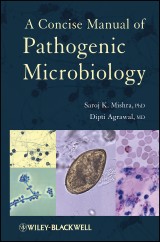Details

A Concise Manual of Pathogenic Microbiology
1. Aufl.
|
57,99 € |
|
| Verlag: | Wiley-Blackwell |
| Format: | EPUB |
| Veröffentl.: | 25.09.2012 |
| ISBN/EAN: | 9781118301203 |
| Sprache: | englisch |
| Anzahl Seiten: | 208 |
DRM-geschütztes eBook, Sie benötigen z.B. Adobe Digital Editions und eine Adobe ID zum Lesen.
Beschreibungen
A quick, concise reference to pathogenic microorganisms and the diseases they cause, this book is divided into specific groups of pathogenic microorganisms including bacteria, protozoa, fungi, viruses, and prions. It lists important pathogenic taxa in each group, covering their natural habitats, the diseases they cause, microbiological highlights, laboratory diagnosis, and measures of prevention and control, including availability of vaccines and effective therapeutic agents. All healthcare professionals and public health workers will benefit from having this reliable source of information at their fingertips.
<p><b>Preface</b> <b>xi</b></p> <p><b>About the Authors</b> <b>xiii</b></p> <p><b>1 Introduction</b> <b>1</b></p> <p>Koch’s Postulate 2</p> <p>Terminology 3</p> <p>Major Categories of Pathogenic Microorganisms 4</p> <p>Transmission of Infectious Disease (Mode of Dissemination) 5</p> <p>Universal Precautions 6</p> <p><b>2 Host-Microbe Interactions</b> <b>9</b></p> <p>Resident Microbiota 9</p> <p>Host Defenses 11</p> <p><b>3 Antibiotics and Other Chemotherapeutic Agents</b> <b>17</b></p> <p>Classification of Antibiotics 17</p> <p>Summary of the Mechanisms of Action 24</p> <p><b>4 Antiseptics and Disinfectants</b> <b>25</b></p> <p>Physical Control of Microorganisms 25</p> <p>Chemical Control of Microorganisms 27</p> <p><b>5 Gram-Positive Cocci</b> <b>31</b></p> <p>Bacterial Taxonomy (An Overview) 31</p> <p>Clinically Important Gram-Positive Cocci 32</p> <p>Gram-Positive Cocci Related to <i>Streptococcus</i> Species 38</p> <p><b>6 Gram-Positive Bacilli</b> <b>41</b></p> <p><i>Clostridium</i> Species 41</p> <p><i>Lactobacillus</i> Species 46</p> <p><i>Bacillus</i> Species 46</p> <p><i>Listeria</i> Species 49</p> <p><b>7 Gram-Positive Bacteria with Rudimentary Filaments</b> <b>53</b></p> <p><i>Corynebacterium diphtheriae</i> 53</p> <p><i>Mycobacterium</i> Species 54</p> <p><b>8 Gram-Negative Cocci</b> <b>61</b></p> <p><i>Neisseria</i> Species 61</p> <p><i>Moraxella catarrhalis</i> 64</p> <p><i>Haemophilus influenzae</i> 65</p> <p>An Overview of Gram-Negative Bacteria 67</p> <p><b>9 Gram-Negative Bacilli</b> <b>69</b></p> <p>Specimen Collection 69</p> <p>Media and Laboratory Diagnosis 69</p> <p>Enterobacteriaceae 71</p> <p>Glucose Nonfermenters 78</p> <p>Uncommon Nonfermentative Taxa 81</p> <p><b>10 Miscellaneous Gram-Negative Bacteria</b> <b>83</b></p> <p><i>Brucella melitensis</i> 83</p> <p><i>Bordetella pertussis</i> 85</p> <p><i>Francisella tularensis</i> 86</p> <p><i>Pasteurella</i> Species 87</p> <p><i>Vibrio cholerae</i> 88</p> <p><i>Aeromonas</i> Species 90</p> <p><i>Campylobacter</i> Species 90</p> <p><i>Legionella</i> Species 92</p> <p><i>Gardnerella vaginalis</i> 93</p> <p><i>Chlamydia</i> Species 94</p> <p><i>Rickettsia rickettsii</i> 95</p> <p><i>Bacteroides</i> Species 96</p> <p><i>Calymmatobacterium granulomatis</i> 96</p> <p><i>Cardiobacterium hominis</i> 96</p> <p><i>Streptobacillus moniliformis</i> 96</p> <p><i>Spirillum minus</i> 97</p> <p><b>11 Spirochetes and Bacteria without a Cell Wall</b> <b>99</b></p> <p>Spirochetes 99</p> <p>Bacteria without a Cell Wall 103</p> <p><b>12 Actinomycetes</b> <b>107</b></p> <p>Anaerobic Actinomycetes 108</p> <p>Aerobic Actinomycetes 108</p> <p>Thermophilic Actinomycetes 112</p> <p><b>13 Introduction to Pathogenic Fungi and Superficial Mycoses</b> <b>113</b></p> <p>Yeast-Like Fungi 113</p> <p>Molds or Filamentous Fungi 114</p> <p>Dimorphic Fungi 114</p> <p>Superficial Mycoses 115</p> <p>Mucocutaneous Mycoses 121</p> <p><b>14 Subcutaneous and Systemic Mycoses</b> <b>125</b></p> <p>Subcutaneous Mycoses 125</p> <p>Systemic Mycoses 127</p> <p>Diseases Caused by Dimorphic Fungi 127</p> <p>Diseases Caused by Yeast-Like Fungi 135</p> <p>Diseases Caused by Filamentous Fungi 138</p> <p>Diseases Caused by Miscellaneous Filamentous Fungi 143</p> <p><b>15 Unicellular Parasites</b> <b>145</b></p> <p>Laboratory Methods in Parasitology 145</p> <p>Diseases Caused by Lumen-Dwelling Protozoa 146</p> <p>Blood- and Tissue-Dwelling Protozoa 149</p> <p><b>16 Multicellular Parasites</b> <b>155</b></p> <p>Lumen-Dwelling Helminths 155</p> <p>Blood- and Tissue-Dwelling Helminths 161</p> <p><b>17 Viruses and Prions</b> <b>165</b></p> <p>Laboratory Diagnosis 166</p> <p>Double-Stranded DNA Viruses 166</p> <p>Single-Stranded DNA Viruses 171</p> <p>Double-Stranded RNA Viruses 171</p> <p>Single-Stranded RNA Viruses 171</p> <p>Prions 179</p> <p><b>Bibliography and Suggested Reading</b> <b>181</b></p> <p><b>Index</b> <b>185</b></p>
<p><b>Saroj K. Mishra</b>, Ph.D is an Adjunct Professor of Microbiology at the University of Houston Clear Lake, Houston, Texas. Dr. Mishra has over 35 years of teaching and research experience in medical microbiology, and holds several patents. The author of numerous peer-reviewed articles, Dr. Mishra also reviews submissions for the <i>Canadian Journal of Microbiology, Applied Microbiology and Biotechnology, Proceedings of the National Academy of Sciences, Journal of Infectious Diseases</i>, and <i>Mycopathologia</i></p> <p><b>Dipti Agrawal</b>, M.D. is a Board Certified physician in internal medicine and infectious diseases. She has over 10 years of experience practicing in infectious disease clinics and hospitals in Houston, Texas.</p>
<p><b>A quick and concise source of information on the causal agents of common infectious diseases</b></p> <p>Pathogenic microbiology is a highly developed branch of microbiology—and while our understanding of the molecular aspects of microorganisms and the host–microbe interactions has grown by leaps and bounds, our need for an old-fashioned source of information still exists. Presented by two authors with nearly a half-century of combined experience in pathogenic microbiology and infectious diseases, <i>A Concise Manual of Pathogenic Microbiology</i> is that necessary source.</p> <p><i>A Concise Manual of Pathogenic Microbiology</i> is a succinct account of the causal agents of most important and common infectious diseases. Divided into chapters based on broad taxonomic groupings or similarities between causal agents, the book lists important pathogenic taxa in each group, their natural habitats, the diseases they cause, microbiological highlights, laboratory diagnosis, and measures of prevention and control, including availability of vaccines and effective therapeutic agents.</p> <p>Beginning with a basic introduction and terminologies, the book covers:</p> <ul> <li>Host–microbe interactions</li> <li>Antibiotics and chemotherapeutic agents</li> <li>Physical and chemical control of microorganisms</li> <li>Gram-positive and -negative cocci, bacilli, and miscellaneous bacteria</li> <li>Spirochetes and actinomycetes</li> <li>Subcutaneous and systemic mycoses</li> <li>Unicellular and multicellular parasites</li> <li>Double- and single-stranded DNA and RNA viruses and prions</li> </ul> <p><i>A Concise Manual of Pathogenic Microbiology</i> will serve as an accessible reference for students, nurses, physicians, public health workers, and other health professionals in need of a reliable, quick reference on infectious diseases and their causal agents.</p>
Diese Produkte könnten Sie auch interessieren:

Zukunftstechnologie Tissue Engineering

von: Will W. Minuth, Raimund Strehl, Karl Schumacher

114,99 €

Zukunftstechnologie Tissue Engineering

von: Will W. Minuth, Raimund Strehl, Karl Schumacher

114,99 €














